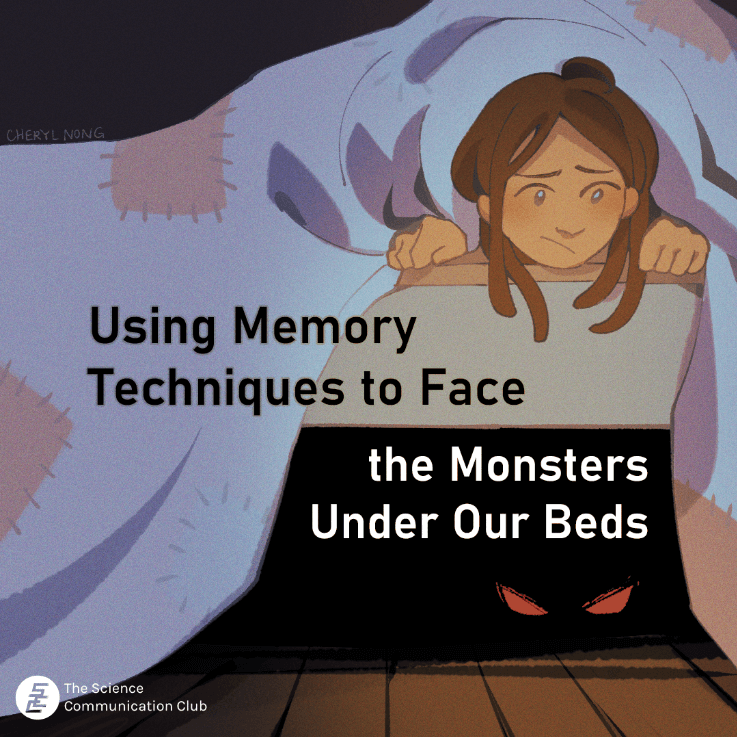
Written by Anne-Marie Bulboaca
Illustrated by Cheryl Nong
Nightmares are no rare phenomenon; every one of us has at some point been forced to confront the monsters under our beds. Medically, a typical nightmare is nothing to be afraid of. Even recurring nightmares are perfectly normal.
Yet for some, nightmares are a constant, unrelenting force of nature. Nightmare disorder, characterized by recurring bad dreams, impairs one’s functioning during the daytime. This results in persistent anxiety, fatigue, low concentration, poor memory, and most importantly, a fear of going back to sleep.1 Psychologists classify this as a parasomnia: a sleep disorder involving an undesirable experience at every stage of sleep. Approximately 4% of adults are diagnosed with nightmare disorder, and it is widespread in patients with Borderline Personality Disorder (BPD) and Post-Traumatic Stress Disorder (PTSD).1
Frequently used treatments include Image Rehearsal Therapy (IRT) and Exposure, Relaxation, and Rescripting Therapy (ERRT). Both are types of Cognitive Behavioural Therapy (CBT), a method of treatment based on three primary principles: psychological problems are rooted in learned patterns of detrimental habits and faulty ways of thinking, so developing healthy coping mechanisms to unlearn these habits can immensely reduce symptoms.2
IRT treats nightmares as controllable issues that can be altered through learned habits. Essentially, patients rescript a nightmare, often with a positive conclusion, and rehearse it daily until it begins to change in their sleep.3 They begin by tackling moderately distressing nightmares before moving on to more intense ones over the course of treatment.3 Meanwhile, ERRT targets a patient’s most intense nightmares. Specifically, patients rescript nightmares based on prevailing themes (such as safety, trust, control, intimacy, and self-esteem) and pair the rehearsal component with relaxation exercises.4

Recently, a clinical study paired IRT with a memory technique called Targeted Memory Reactivation (TMR).5 With this technique, participants focus on learning while a sound plays in the background. The same sound is then played again during their sleep, activating and strengthening the associated memory. In the study, IRT patients rehearsed their rescripted dreams while a piano riff was played. This riff was then played every ten seconds while the participants were in Rapid Eye Movement (REM) sleep.5
REM sleep is the phase of the sleep cycle when dreams occur. It is a light sleep where brain activity closely mirrors the brain’s awakened state.6 This is the phase of sleep where memories are consolidated, specifically, declarative (fact-based) and procedural memories. For an IRT patient, these forms of memories are critical in establishing a rescripted dream.7
The study found that the TMR-IRT combination was extremely effective in helping patients eliminate nightmares. The weekly average for the group that used this technique was brought down from three nightmares per week to 0.2. The control group (IRT only), however, only experienced a drop to one nightmare per week. This technique also increased the staying power of the rescripted dream, even after halting the treatment.5
Nonetheless, this technique also has its limitations: accurate brain patterns are not yet widely accessible to the public, and some patients may struggle to connect the rescripted dream with the sound. Moreover, larger studies must be done to determine the impact of this treatment on a greater scale. Despite these drawbacks, this research has the potential to be ground-breaking in the treatment of patients suffering from PTSD. The goal is to eventually improve the quality of life of countless people around the world.
Sources:
- Nightmare disorder: Symptoms, causes, treatment, and prevention. 2021. Psych Central. [accessed Oct 31 2022]. https://psychcentral.com/disorders/nightmare-disorder-symptoms
- What is cognitive behavioral therapy? 2022. Washington (DC): American Psychological Association. [accessed Oct 31 2022]. https://www.apa.org/ptsd-guideline/patients-and-families/cognitive-behavioral
- What is imagery rehearsal therapy (IRT)? 2021. Psych Central. [accessed Oct 31 2022]. https://psychcentral.com/blog/a-brief-guide-to-imagery-rehearsal-therapy-irt-for-nightmare-disorders-for-clinicians-and-patients#next-steps
- Psychosocial treatments for trauma based nightmares. 2018. Psychiatric Times. [accessed Oct 31 2022]. https://www.psychiatrictimes.com/view/psychosocial-treatments-trauma-based-nightmares
- A new treatment for debilitating nightmares offers sweeter dreams. 2022. Washington (DC): Science News. [accessed Oct 31 2022]. https://www.sciencenews.org/article/treatment- nightmares-sleep
- Sleep Basics. 2020. Cleveland (OH): Cleveland Clinic. [accessed Oct 31 2022]. https://my.clevelandclinic.org/health/articles/12148-sleep-basics
- Healthy Sleep: Sleep, Learning, and Memory. 2007. Boston (MA): Harvard Medical School. [accessed Oct 31 2022]. https://healthysleep.med.harvard.edu/healthy/matters/benefits-of- sleep/learning-memory